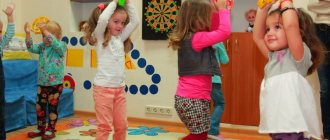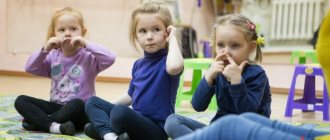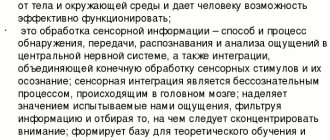In our time of high technology and computerization, when children, having barely learned to walk, already sit for hours at the computer, the topic of introducing a child to physical education and sports is very important; the question of the physical health of children arises. Our generation will never be healthy if physical education and sports are not properly introduced into the development process of children. And the sooner a child gets involved in gymnastics, the better, naturally.
A peculiarity of the development of preschool children is that all their motor skills have not yet been fully formed. That is why sitting or standing for a long time, incorrect posture, as well as furniture that is not appropriate for the child’s age, adversely affect the formation of the skeleton and ultimately lead to poor posture. Thus, it is obvious that children’s gymnastics is very useful for a developing organism. It has a very beneficial effect on the respiratory, cardiovascular and autonomic systems. In addition, gymnastics for children helps strengthen the immune system, and also increases the body’s performance and endurance.
The benefits of gymnastics for children
During the lessons the following develops:
- coordination. The child feels his body and knows how to control it;
- plastic. It will be very useful if you choose a sports career in the future;
- healthy musculoskeletal system;
- fight against excess weight. Many children suffer from this problem from an early age.
Additional benefits appear if children study not at home, but in clubs. There they will be able to develop not only physically, but also improve their communication skills and find new friends. And demonstration performances, if they are held at least for parents, help to gain self-confidence and not be afraid of the public.
It is important to adhere to proper nutrition. Without a routine and diet, gymnastics will be ineffective, and sometimes even harmful (for example, if you exercise immediately after a hearty lunch).
Psychologists say that gymnastics and the gradual development of muscle structure, endurance, and plasticity allow the child to understand that nothing can be achieved quickly and without difficulty. Children develop a correct outlook on life and realize that their goals are not achieved immediately.
Exercises for articulation gymnastics
Repeat each of the proposed exercises 10-15 times.
- "Proboscis". Children should be invited to play with elephants, fold their lips with their proboscis, hum for a second, and return their lips to their normal position.
- "Needle". Children are invited to play with the needle with their tongue: open their mouth wide and make movements with their tongue, like a needle when sewing. Then close your mouth, but open your jaws as much as possible; there should be a lot of space in your mouth (only your lips are compressed). You need to “prick” with your tongue one cheek at a time, then the other.
- "Hamster." Playing the hamster is simple, you need to inflate your cheeks as much as possible, hold them there for 5 seconds, then slap your cheeks sharply with your hands, deflating them.
Any gymnastics is important for a 5-year-old child. Don’t be lazy to exercise with your baby, because with the help of exercises he becomes healthier, develops faster and better.
Features of children's gymnastics
Gymnastic exercises for children should first of all be adjusted to their age category . Children 3-4 years old are not able to perform complex and intricate movements, because they have not yet learned to control their body. And the task of training is precisely this training.
Exercises are also divided by gender . For boys, gymnastics is usually chosen for endurance, for girls - for the development of plasticity. When creating an individual training program, the personal characteristics of the child are taken into account. Some children at 3 years old are quite capable of performing the exercises of 5-6 year olds.
For girls and boys
Very young children are not allowed to do gymnastic exercises. They only change with age. Already after 7-8 years, it is clearly noticeable that girls are slightly inferior in strength and endurance to boys, with the same initial data. In subsequent years the difference becomes significant.
But there are several rules that are the same for everyone:
- Do not use home weights unless they are recommended by your trainer. Dumbbells or weights should be used by knowledgeable people. Children do not understand the capabilities of their body and are not familiar with the rules of physical activity. They may misdistribute their weight, leaving them injured for life;
- The younger the child, the shorter the gymnastics should be. It is better to introduce several visits a day, but no more than 5-10 minutes. Otherwise, children will become uninterested in studying and will stop trying;
- Do not lift heavy weights and do squats or other exercises with them. You can only work with your own body weight. This rule continues until posture is formed.
Boys are usually given exercises in which the load is distributed by the weight of their own body.
These include:
- squats;
- push ups;
- pull-ups on the horizontal bar;
- push-ups on parallel bars.
These exercises are also suitable for girls, but it is better to choose those that develop posture and grace in movements:
- leg-split;
- bridge;
- tilts in different directions;
- buckles on a jump rope or in length;
- training with stretching of different muscle groups.
Stretching cannot be done at home. It should be supervised by a trainer so as not to injure the child’s muscles and ligaments.
For different age groups
Gymnastic exercises for children and recommendations for building workouts can be viewed in the table:
| Age group | Basic Rules | Class time | Working with a trainer | Recommendations |
| 3-4 years | Lack of shoes, otherwise the foot apparatus will develop incorrectly; Constant repetition of exercises to develop physical memory | 5-10 min. | Mirror: children repeat the movement after the person who shows them | Musical accompaniment, a program based on dance and imitation of song characters |
| 5-7 years | Introducing complex coordination exercises and repeating them repeatedly | 10-15 min. | Single demonstration of exercise followed by counting | The game form of doing the exercises is preserved, but without music, so that children can clearly hear the count and follow the instructions |
| 8-10 years | Strength and acrobatic training elements are being introduced, and gymnastics for girls | From 20-30 min. | At the instruction level. The coach explains the actions, the child performs | Sports equipment is introduced, for example, you can climb a rope, jump on a trampoline or perform exercises on rings with elastic bands |
Physical exercise is required for a child at any age. When they become systematic, immunity increases. And children get sick noticeably less often than their peers.
Also, from the age of 8 years, body proportions are formed. Gymnastics helps keep them in harmony and set a healthy direction in development. Therefore, up to 8 years of age you can do training at home, but after that it is better to turn to professional trainers so as not to harm the child.
Why do you need exercise in the morning?
Regular morning exercise is more important for children than for adults. Preschoolers and schoolchildren are forced to lead a less active lifestyle, being mostly indoors - which is why children so often have problems with posture, weight, and physical development in general.
A simple home routine, regularly performed in the morning, has only a positive effect on the child’s body:
- strengthens the immune system, which primarily suffers from insufficient physical activity;
- strengthens the spine, which may develop incorrectly due to a sedentary lifestyle;
- improves the functioning of the cardiovascular system: children who regularly do morning exercises are less likely to experience weakness and are less susceptible to changes in blood pressure and fainting;
- strengthens the muscle corset, maintaining a healthy back and beautiful posture;
- fosters determination and the ability to plan.
As a professional, I’ll say this: everyone needs exercise: seniors and juniors. Regardless of age, minimal physical activity should be present in the life of every person: strengthening the muscle frame, body tone and good spirits - this is the minimum set of reasons “why exercise is needed.” If parents teach their child to be physically active from an early age, then in the future he will do exercises on his own. Of course, to make it easier for your child, you should do all the exercises together,
– Anton Golotsutskov,
Russian gymnast, Olympic medalist, champion of Russia and Europe, president of the charitable foundation “Health for Children through Sports.”
What features of morning exercises need to be taken into account to ensure that the exercises are safe and bring maximum benefit:
- exercises are performed on an empty stomach, after hygiene procedures - exercise does not involve high loads, and you can have breakfast immediately after completing the complex;
- maintain regularity - only systematic exercises have a positive effect;
- do not overdo it with the duration of the exercise - for children under ten years old it is enough to spend 10-15 minutes on exercises;
- take time to warm up - you can start preparing the child’s body for physical activity immediately after waking up, while the child is still lying in bed, using the simplest movements: raise and lower your arms, twirl your hands, clench and unclench your fingers;
- If possible, do exercises outside; if that doesn’t work, then in a well-ventilated area;
- try to diversify the activities taking into account the child’s age: turn on fun music or a suitable video lesson, add new exercises every two weeks;
- teach your son or daughter to breathe correctly: inhale through the nose, exhale through the mouth - correct breathing makes it easier to do morning exercises and makes it more effective;
- follow the principle “from simple to complex”, gradually complicating the complex and giving the child enough time - at least two weeks - to get used to the same load;
- do not interrupt the exercises abruptly, include the final stage in the complex: for example, stretching, running or walking in place;
- Teach your child to finish classes with water procedures: contrast showers, douches.
Charging must be done in a ventilated area, immediately after waking up and before eating. I recommend it with energetic music that your child likes to set him up positively for the whole day. Be sure to monitor the correct execution and breathing. If a child is sick or feels unwell, classes should be interrupted until he returns to normal.
– Anton Golotsutskov,
gymnast, Olympic medalist, Russian and European champion, president of the Children's Health through Sports Foundation.
Safe charging conditions:
- choose suitable clothing for training: made from natural fabrics, without large seams, without zippers and without buttons - the training uniform should not create inconvenience;
- when exercising at home, you don’t have to wear shoes, but socks are a must;
- prepare a place for charging: make sure there is enough space in the room, remove objects from the floor that could accidentally injure the child, if necessary, prepare sports equipment (jump rope, ball, mat).
Morning exercises can only be harmful if the exercises are performed incorrectly, as well as the individual characteristics of the child. If there are any, consult your doctor, he will tell you which exercises you can use and which ones are best avoided. In any case, proper gymnastics cannot harm, you just need to take into account the level of possible stress,
– Anton Golotsutskov,
gymnast, Olympic medalist, Russian and European champion, president of the Children's Health through Sports Foundation.
When and how long can you exercise?
If we are talking about regular exercises, then you need to do it every morning before breakfast. You can come up with an entertaining set of exercises that children will do while making the bed.
If we are talking about big professional sports, then the schedule will be as follows:
- 1-3 years – 2 times a week;
- 3-5 years – 3 times a week;
- from 5 years – more than 3 times a week.
There are also a few general rules to keep in mind:
- you can combine different sports, but take into account the total physical load on the child;
- 1 day must be a day off, completely free from intensive classes;
- the load increases gradually. During classes, the child improves physical fitness and endurance. Therefore, the regularity and intensity of training can be increased every year.
Every day you need to devote at least 60 minutes to physical activity. The younger the child, the more often they do exercises. It takes 5-10 minutes with breaks of 1-3 hours.
Advice from professional children's trainers on conducting gymnastics:
- the air in the room should be fresh. If possible, it is better to go outside, or ventilate the room well, and conduct the classes themselves with the windows open;
- comfortable clothes. It is important that it does not restrict movement and that the seams do not chafe;
- rule 8mi. For each approach, regardless of age, you need to do 8 different exercises, 8 approaches each;
- breathe through your nose. During physical activity, breathing becomes faster. When air passes through the nose, dust and small, almost invisible debris settle on the mucous membrane and hairs. The air also warms up and enters the lungs clean and warm. If you breathe through your mouth, then the exercise will do more harm than good, because frequent breaths will pollute your lungs much faster.
Psychologists say that the behavior of children depends not on upbringing, but on the example of their parents. Therefore, in order for a child to systematically do exercises, adults must show him how important this is.
Where to begin
Starting from the very first lesson, make sure to perform the exercises at the correct pace.
How to maintain a safe and efficient pace for your child during morning exercise:
- Follow the principle of any workout: warm-up - main part - final part (cool-down). Even beginning athletes usually remember to warm up, but the cool down is often neglected. The final stage of physical activity is as important as all the others - let the child finish the exercise with a slow step in place or simple stretching exercises.
- Set the correct speed when performing exercises: first slowly and gradually accelerating, move on to the fastest possible version of the movements. You also need to slow down little by little—pediatricians do not recommend that children, especially preschool and primary school age children, suddenly stop fast movements.
- Remember that quality is more important than quantity - let the child do deep bends to the sides five times, observing breathing technique, rather than perform twenty quick shallow bends, forgetting about proper breathing.
Warm-up
Warm-up is needed to prepare and “warm up” the muscles and joints. If you skip the warm-up and go straight to the main part of the workout, there is a high risk of injury. Warm-up option for preschoolers, spend about one minute on each exercise:
- walking in place;
- running in place at a calm pace;
- wave your arms.
A warm-up for a preschooler can be accompanied by a story about the exercises that you will do in the main part of the workout, or you can start a fairy tale that leads to the start of the main classes.
Where to start morning exercises for a child - a warm-up option for elementary school students:
- bends: hands on the belt, bends are performed sequentially - left, right, forward, backward;
- rise on toes (5-6 repetitions): inhale - spread your arms wide to the sides, exhale - stretch up on your toes as high as possible, stay in this position for a short time and lower;
- exercise for shoulders and arms: alternately, and then together, raise and lower your shoulders, then alternately perform arm swings;
- head tilts (4-6 repetitions) - head tilts to the left and right are performed at a leisurely pace, then you can move on to neat circular movements clockwise and counterclockwise.
Another option for a short children's warm-up:
Breathing exercises
If it is difficult for a child to catch the required breathing rate, do additional breathing exercises with him to develop the habit of breathing correctly during physical activity. In addition, breathing exercises have a beneficial effect on the functioning of the respiratory system and even on the formation of the speech apparatus. You can start breathing exercises on your own no earlier than five years old, following the general rules:
- the child should be in a calm, even mood and should not be upset, excited or tired;
- tasks are completed at a calm pace under the supervision of an adult;
- sharp exhalations are prohibited;
- It is especially important to monitor the position of the child’s shoulders: they should be in a calm state - not rising or falling.
A set of breathing exercises to improve physiological and speech breathing:
When a boy or girl learns to breathe correctly, still periodically include elements of breathing exercises in your daily training: for example, complete the warm-up by breathing together through your nose and exhaling through your mouth.
A good way to get a child, whose physical activity has always been minimal, interested in the idea of morning exercise is walking in the warm season. While walking, you can gradually move from slow walking to fast walking, and later to running. When the child gets used to the loads, he will probably want to learn new movements himself, and then you can offer him to include daily morning exercises in his regimen.
Contraindications
Gymnastic exercises for children, which need to be performed every morning, have almost no contraindications. If the child feels great and has no problems with joints or blood circulation, then you can safely start exercising, and constantly add new complexes, or increase the duration of old ones.
You should be more careful if you have health problems. Doctors consider the following list of contraindications:
- colds, any other temporary infections. While fighting the virus, your body temperature rises. And any physical activity raises it further, which can lead to complications and chronic diseases;
- inflammation. Body temperature rises, and gangrene and purulent infections may develop in areas of inflammation, as a favorable environment for bacterial growth is formed;
- bleeding. Physical exercise accelerates blood circulation, causing the flow to become even stronger;
- blood pressure problems. If they are temporary, then you need to stop morning exercises until recovery. When your blood pressure is constantly abnormal, you should consult your doctor. He will tell you what specific exercises you can do, and they will not harm your health;
- malignant tumors. With such serious diseases, the body should not be given additional stress, since it has to spend a lot of energy to fight the disease.
Physical activity is not recommended during the recovery stages. You need to give your body time to finally get stronger, and only after that resume gymnastics.
Developmental exercises
There are many exercises for finger gymnastics for children 4-5 years old. You can simply organize a shadow theater every day, where the heroes will be hands and fingers (you need to place them so that the shadows resemble various animals or figures). You can also do other exercises, but only in the form of a game:
- "Scratchy scratches." The children imagined themselves as cats and cats, their hands clasped at the elbows, hands at head level. Four fingers should be pressed to the top of the palm with pads, and the thumb should be pressed to the bent index finger - these are cat paws. We try to press our fingers tightly, and then sharply open our palms, the fingers are tense in a position as if a cat is releasing its claws. Repeat the exercise several times.
- "Barbel beetle." Hands into fists, we extend the index finger and little finger (“Goat”) to the sides, you can run around, moving your fingers, and at the same time buzzing “zhzhzhzhzh.” Then we open our palms and fly!
You can clench and unclench your fingers, let the child “walk” with his fingers on your palm, “draw” with them.
How to make classes not boring
If a child happily takes up gymnastics without additional motivation, no entertainment is needed. Exercise is a useful and mandatory event. Over time, children need to be taught to perform it, even if there is no musical accompaniment or other element without which classes were not started before.
To diversify gymnastic exercises, make them not boring and interesting, you can:
- allocate a sports place. Here the child can store his sports equipment and practice;
- buy sports equipment. Children work with their own weight, but still some things will come in handy - a jump rope, a ball, a mat for doing exercises in a lying position;
- musical background. It is best to select compositions from your child’s favorite cartoons. This way he develops pleasant associations with his activities.
Psychologists recommend avoiding gymnastics altogether if children are in a bad mood in the morning.
If you force someone to do it through force, a negative impression develops. Subsequently, the child will look for different ways not to do exercises. Experts from the Nemours Foundations report that playing with characters has a positive effect on exercise. Every day, different heroes are invented for the child (for example, a hunter or a rescuer). He tries on the role, and as if he is doing the exercises for another person. This approach helps to cope with laziness and overcome bad mood.
Some important tips for parents
To ensure that exercise remains a pleasant time together, without turning into a tedious chore, follow these simple recommendations:
- give the child tasks within his ability: appropriate to his age and abilities;
- cancel classes at the first sign of illness;
- stop the exercise if it causes pain;
- include elements of play in the training - the younger the child, the more play moments there can be;
- periodically change the course of your classes and add new exercises, gradually add a variety of sports equipment.
The main charging rules that parents need to follow:
The invited expert, Russian gymnast, medalist of the Beijing Olympics, champion of Europe and Russia, as well as the president of the “Health for Children through Sports” charity foundation, Anton Golotsutskov, shared simple but very important components of children’s morning exercises:
- Simplicity - do not invent complex combinations, the child should not spend a lot of energy on exercises, he should just warm up.
- Regularity – you need to develop a habit, so don’t be lazy and study together for at least 5 minutes every morning.
- Interest - try to diversify your exercises every week, come up with funny names for exercises, change equipment. You can do exercises pretending to be characters from your child’s favorite cartoons. The main task is to awaken a child’s love for gymnastics.
It is possible to make exercises safe and effective for your child: act consistently, and soon your son or daughter will get used to morning exercises as a daily ritual, such as brushing their teeth. Of course, all methods of teaching a child to be physically active are good. But the most effective way to instill a love of physical education is by example. Do exercises every morning, and even the most unsportsmanlike child will join you sooner or later!
3
Preparing to charge
To prepare for charging, you can use the table:
| Nuances | Rules | What is it for? |
| Cloth | Tight-fitting, with a minimum of seams. Hardened children can work in shorts and a T-shirt even in winter | Loose and wide clothing can snag on sports equipment or interfere with normal joint movement |
| Shoes | Socks, leg warmers or special half shoes (sold in sports stores) | Do not interfere with the normal development of the foot, prevent the appearance of flat feet |
| Inventory | Balls, jump ropes, hoops (must be selected according to the child’s height) | Promotes bodyweight exercises |
| Additional items | Knee pads, mats for supine exercises | Does not wear out your knees, allows you to carry out the lesson comfortably |
Free space is allocated for charging. Usually the exercises are done in the living room near the TV, on which cartoon music is played.
Before you start charging, be sure to do a warm-up. It increases heart rate, breathing and warms muscles and tendons.
A high-quality warm-up prevents the occurrence of injuries during gymnastics.
Warm-up includes the following actions:
- Cardio warm-up. Exercise – walking in place with high knees;
- joint gymnastics. Exercises – alternate movement of joints;
- muscle stretching. Exercise – spreading your legs (splits), spreading your arms to the sides and back;
Gymnastic exercises for children to stretch muscles - restoration of breathing. Exercise – arms up as you inhale, down as you exit.
Dance steps
Goal: to consolidate the ability to hear the rhythm and beat of music, the ability to coordinate movements and change them when the music changes.
Children stand in a circle one after another. The teacher turns on a musical composition. Children begin to move in a circle at a normal pace. As soon as the music changes, the children's movements also change. For example, after a step, children move to a run, then to a side step, then to a half-squat step. The teacher can command which step the children need to go to when changing the music, or simply switch the music. It depends on the preparation of the children.
Approximate sets of exercises for children at home
Gymnastic exercises for children are selected in full accordance with the age of the child. Depending on his physical abilities, a set of classes is formed.
Before starting gymnastics, a warm-up must be performed.
4-5 years
Exercises at the age of 4-5 years are aimed at muscle development.
A complex performed according to the instructions is ideal:
- The position is assumed lying on the stomach. The child needs to alternately raise his arms and legs up (as far as possible).
- The prone position is maintained. The child raises 1 arm and leg, while he learns to pull the toe on his foot.
- The child turns over onto his back. First, they raise their legs and do the “bicycle” exercise. Then it changes to “scissors”, when the legs are crossed in shifts.
- The “birch tree” exercise is performed while lying on your back. The legs are raised high, the toes are extended. Next, raise your hips and help them with your hands. Resting your elbows on the floor, your torso rises as high as possible, while keeping your legs in a level position. You need to hold this stance for 3-5 seconds.
- Take a standing position with your feet shoulder-width apart. Squats are performed. Parents need to make sure that the child is constantly breathing, because many people hold their breath until the exercise is completely completed.
- A kneeling position is assumed. Hands are extended forward and placed on the floor. You need to stretch, slightly swinging your body. The exercise is called "cat" because of the similarity in movements.
Each exercise is performed 8-15 times, depending on the child’s physical fitness.
6-7 years
The range of activities for preschoolers is changing. They require more space since most exercises are activity-based.
The complex is divided into stages:
- Run. There is no need to control that the child runs in a straight line or maintains a certain pace. He can wobble, accelerate and start walking quickly. Running time – 35-40 seconds.
- Jumping. Alternate jumps with a lunge forward, on one leg, in place and over a rope. Each pass is performed 15-20 times.
- Push ups. To begin with, use a surface approximately 40-50 cm above the floor level as a stop. Over time, the bar is gradually lowered until it reaches floor level. Performed 10-15 times.
When just switching to active exercises, their duration starts from 3-5 times (for running - from 15-20 seconds).
Over time, the number increases. This gradual increase in activity allows the child to adapt to the new rhythm without harm to health. You can add a ball game to the set of exercises. He is thrown into the wall, then caught. It’s better if parents and children take turns catching, then there will be more activity in the exercise.
8-10 years
There are a lot of gymnastic exercises for children 8-10 years old. Here the child will have to concentrate, since they involve stress on different muscle groups. You need to perform several actions at the same time, which requires concentration, which preschoolers lack.
Standard set of exercises:
- Starting position (hereinafter referred to as IP): arms along the body, legs together. Walking in place with high knees is performed. Time: 1 min.
- IP: similar. As you inhale, the arms rise up, and the left leg is pulled back, the toe is extended. On exhalation, IP is taken. Then the process is repeated with the right leg. For each, perform 10 approaches.
- IP: standing, feet shoulder-width apart, arms bent at the elbows, at the waist. Bends to the sides are performed, raising and extending the arm (if the tilt is to the right, the arm is left). Each incline requires 10 approaches.
- IP: legs spread wide, hands on the belt. As you exhale, you need to lean forward and reach with your left hand to the toe of your right foot. Then the process is repeated with the right hand, for each 10 approaches.
- IP: feet shoulder-width apart, arms bent at the elbows and palms connected in front of the chest. The body is rotated in different directions. At the same time, the elbows spread to the sides. Returning to IP, your elbows need to be pressed together. 10 approaches are performed for each side.
- IP: feet shoulder-width apart, hands on the belt. Partial squats are performed (when the angle of the bent knees is approximately 90 degrees). In this case, the arms are extended forward, but when lifted they return to their original position. Squats are useful for normalizing blood circulation, functioning of the digestive organs and training endurance. Therefore, there should be as many approaches here as the child can complete. The main thing is to maintain a moderate pace and take your time.
- IP: on the floor, emphasis is placed on the palms and toes. Perform regular push-ups 8-10 times.
- IP: standing, hands on the belt, legs slightly apart. Perform 30-40 jumps at a moderate pace. For experienced and resilient children, jumping rope is suitable.
- IP: as when performing 1 exercise. Walking in place is performed with a gradual slowdown in pace. Time: 1 min.
After 10 years, you can add sports equipment to the exercise to increase the load - dumbbells, weights. It is better to do this after consultation with a professional trainer.
How to get your child interested in doing exercises
For senior preschool (6-7 years old) and primary school (8, 9, 10 years old) children, activities that are not designated by parents as strictly mandatory are interesting. The easiest way to involve children in doing exercises is for parents to start doing the exercises themselves: a preschooler will probably want to repeat after an adult, and a schoolchild will at least ask what exactly mom or dad are doing.
You can start teaching exercises as early as 2-3 years old. At first it will be basic exercises, literally 5 minutes of warm-up every morning. Already closer to school age, in the period from 6 to 10 years, we increase the charging time to 10-15 minutes and the complexity of the exercises accordingly,
– Anton Golotsutskov,
gymnast, Olympic medalist, Russian and European champion, president of the Children's Health through Sports Foundation.
How to strengthen your child’s interest in morning exercises:
- introduce game elements into daily tasks - for children 6-8 years old. For example, imagine together that you have come to a magical clearing and now you need to wave your arms like a butterfly’s wings, bend over as if picking flowers, jump like a cheerful bunny;
- choose music for classes: you can use the same music, and exactly the one that the child likes. Doctors specializing in physical therapy claim that upbeat music helps a person at any age get in the mood for physical activity;
- replace - constantly or sometimes - regular training with poetic exercises - for children 6-7 years old. Suitable poems can be included on audio, video, or spoken out yourself. Option for children's exercises with poems:
- Praise your child every time he completes a routine. Remind him that every day his body becomes more physically strong and healthy, and his muscles become more beautiful.
An enthusiastic child who understands why he is engaged in physical education will perform all the tasks provided for in the morning routine. Some children are so inspired by their initial successes that they begin to exercise too intensely, and as a result they become tired and do not feel energetic enough during the day. If your child is too persistent in doing exercises, remind him that the purpose of exercise is to awaken the body, not tire it, and suggest creating a training plan:
- a plan for each day - drawn up on the eve of each lesson: all the exercises of the complex are prescribed in the plan and marked where additional equipment will be useful;
- a plan for introducing new exercises - done in the form of a table, noting with what frequency new exercises will appear in the complex;
- a long-term plan is prepared for a long period of time: for a week or a month, marking the sequential mastery of the complex’s classes and the introduction of new exercises.
Write down the planned lesson plan on a piece of paper and place it in a visible place. Together with your child, you can draw up a plan beautifully and ask your son or daughter to independently celebrate the planned achievements - direct participation in drawing up the plan will motivate the child to study constantly, without doing unnecessary exercises.
Teaching gymnastic tricks
You can learn gymnastic tricks for a child whose physical abilities are good enough for this.
If you send children to professional sports from an early age, the following statistics are observed:
- 1.5-2 years. The child masters the simplest skills that develop his dexterity and the ability to group himself when falling.
- 3 g. The exercises are based on maintaining balance, and also stretch the muscles and develop flexibility.
- 4 g. The trainers gradually introduce the simplest tricks into the program - somersaults, splits, bridges, wheels.
- 5 years. Studying complex coordination movements separately, which will later be assembled into serious tricks.
- 6 years. Exercises on gymnastic apparatus are introduced. Difficult tricks are performed with insurance and under the close supervision of a trainer.
For a child to perform his first difficult trick, he needs to train for 4-4.5 years. The later children come to professional sports, the more difficult it is for them to develop flexibility, agility, and coordination. Therefore, teenagers will need much more time to perform the first trick.
Regardless of whether the classes are professional or home and amateur, gymnastic exercises are of great benefit for the development of children.
They affect not only their physical fitness and endurance. With the help of training, you can develop discipline, aspirations and desire to work on yourself and your skills.
Why do you need to do gymnastics?
You need to work with children from birth and throughout their growing up period. Gymnastics for a 5-year-old child (as well as younger and older children) is necessary for physical activity, good functioning of metabolic processes, and in general it is a boost of energy for the whole day!
Regular exercise has a positive effect on a child's health. Performing exercises affects:
- to strengthen muscles;
- increased appetite;
- increased vitality;
- activation of internal organs (especially respiratory organs, cardiovascular system);
- development of coordination;
- formation of correct posture;
- discipline;
- durability;
- increased mood;
- slow children become more active, overly excitable children calm down a little.
Physical exercises about space
Let's fly
One two three four five. Let's fly together into space (Children raise their hands up). Let's break away from the Earth (Make a jump on the spot). We will fly to the moon (Hands to the sides). We’ll hang in orbit and we’ll all fly back (Hands to the sides and make turns).
Astronaut
Don’t yawn on the sides (Make turns on the sides). Today you are an astronaut! Well, let's start training! You will become strong and agile (Lean in different directions). The rocket is already tired of waiting. We will fly to the planet (Hands to the sides). We will all get to Mars, the stars will be around us (Spin).
Funny competitions for children: see HERE!
Fun exercise (video)
Physical education minutes form a positive attitude towards various situations that may arise in a team (both in the kindergarten and at school). For example, if during a break there was a fight between children, in order to divert the children’s attention from what happened, reconcile them and prepare them for the lesson, you need to warm up in a playful way.
Physical exercises do an excellent job with this task. Undoubtedly, physical fatigue resulting from sedentary activity will also help correct physical exercises. According to SanPiN, the continuous educational activity of preschoolers can range from 10 minutes (younger preschoolers) to 25 minutes (preparatory group). And during the break you need to do physical warm-up. You need to devote time to them in the middle of the lesson and at the end, when the children are too tired.
Health to you and your children! Natalya Belokopytova.
Physical exercises for children 2-3 years old
Three Bears
Children imitate the gait of a bear and repeat:
Three bears were walking home. They raise their hands up and say: Dad was like this! Mommy was smaller (At this stage, the children stretch their arms in front of them) and the son was small (squat down). He was painfully tiny. He kept wearing rattles. (They rise, wave their arms and pronounce sounds: tryn-tryn-tryn).
Owl
It got dark in the forest, everyone went to bed. (Children squat down.) An owl sits on a tree, then flies, then screams (Hands to the sides). The owl sat on a branch, turning its head around (Children draw a huge circle with their hands, squat and turn first to the right, then to the left). Everything looks around, then suddenly it flies again. (They get up, wave their arms, run in place).
“HOW TO STRENGTHEN A CHILD’S IMMUNITY” read HERE
Masha is confused
Our Masha is confused, she has lost her things (Turn in different directions). And there is no chair (Turn in the opposite direction). And not under the chair. This is Masha (Children bend in different directions and shake their fingers). Masha is confused!
Rocket
Well, get ready, kids, We'll fly on a rocket. Children should stand up and put their hands down. They repeat: One, two, three, four, five, - We begin to take off!
At this stage, children stand on their tiptoes and use their palms to imitate the dome of a rocket.
Now let's stand up. (Children straighten up.) And now let’s all take steps. (Children mark time.) Let's stretch up (Stretch your arms up). And we will all bend back (Bend our backs), And now we will all sit down. (They squat down.) Then we will all stand up together again (Stand up).
How to properly develop a child physically while he is small?
Fabulous physical exercises
Physical exercise on the theme of fairy tales is intended for preschool children. Fairy tales of any genre can be used for reading: fairy tales, folk tales, Russian ones.
Droplets: dance physical exercise
Kolobok
Kolobok, kolobok, round and ruddy (Children bend in different directions). He keeps jumping forward, but doesn’t know where (They jump on the spot). Here he turned right, and then left (Make turns on the sides). Here he was spinning in place (Spinning in place). Then he became friends with the bunny (They squat down). He rolled further (Move forward slowly).
Multicharging
Teremok
Terem, tower, tower. You are not low, not high (Children first lower their hands, then raise their hands up). The frog is jumping in it (They jump on the spot). The chicken cackles (Waving their arms). The mouse dances merrily (Dance). The hedgehog has locked the doors and is guarding our little house (Children clap their hands).
Guidelines for conducting musical exercises in preschool educational institutions
Morning exercises are carried out in a pre-ventilated room: in a group, sports hall or music hall. The teacher and children wear comfortable clothes and shoes, preferably a set for physical education (girls can wear gymnastic swimsuits). In the warm season, it is recommended to do exercises outside: on a group site or sports ground.
For physical and dance training, you need to wear sportswear - it is comfortable and aesthetically pleasing.
Musical compositions are selected for a full complex of exercises: introductory, main and final parts. It is best when children practice to the accompaniment of a music director. But this is impossible for daily practice: each group does exercises at the same time (before breakfast), and the music director and the hall are singular. To the accompaniment of live music, exercises such as travel, dance exercises, and an open demonstration of exercises are carried out.
Exercises can be performed in the form of a journey or with the participation of fairy-tale characters to live accompaniment
Exercises carried out in an unusual form will help quickly involve all students in the process of doing exercises and set them up for further activities in kindergarten.
Songs and melodies are usually played on a tape recorder or music center. It is convenient to save audio tracks for charging in folders with the names of gymnastic complexes on your computer or laptop. Music should be clearly audible anywhere in the room; if necessary, the teacher connects audio speakers to the computer.
The instructor can use the player and speakers for musical exercises
The use of ICT (information and communication/information and computer technologies) is encouraged in the work of kindergarten teachers. During a morning exercise class, you can use an interactive whiteboard or canvas to display pictures (in thematic and story-based exercises), animations or other funny videos as a reminder of movements.
Video: song “Fun exercises with Kukutiki”
“Exercise with Kukutiki” is suitable as a warm-up for children in middle and senior groups. The tempo of the music and the rhythm of the movements are high; younger preschoolers will get confused, confused, and exercises will be ineffective.
Video: warm-up with kids
The video is suitable for watching and repeating exercise movements in younger groups. Malyshariki are characters from educational cartoons for the youngest viewers. Favorite characters are a great way to motivate kids to get a good workout.
Each charging stage is accompanied by an audio recording of the corresponding tempo and melody:
- introductory stage: rhythmic music of moderate tempo activates children’s attention, a short warm-up is performed to it;
- main stage: songs and melodies of moderate and high tempo for performing general strengthening exercises and continuous running (at the end);
- completion: calm music for sedentary play or breathing exercises.
Each charging stage must be accompanied by music of a certain tempo.
The teacher compiles a card index of musical exercises. For each topic, the names of audio compositions and a list of exercises for them are indicated.
Table: example of filling out the music exercise card “Training of future pilots” in the senior group
| Charging stage | Musical accompaniment | Physical exercise |
| Warm-up | March of the Aviators (backing track of the song “We were born to make a fairy tale come true”). |
|
| General strengthening exercises |
|
|
| Completion | Instrumental composition “Song of the East Wind” by V. Saiko. | Breathing exercises:
|
Some exercises of morning gymnastics to music (especially dance elements) are performed with sound attributes: tambourines, rattles (homemade maracas), rattles, bells. During exercises, musical instruments are used that children are already familiar with playing. While performing the exercises, the skill of elementary music playing is trained - getting to the beat.
The use of simple musical instruments by children while exercising develops a sense of rhythm in preschoolers









